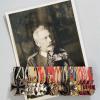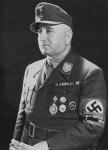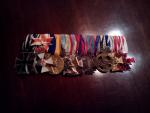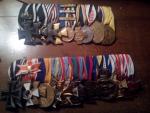-
Posts
631 -
Joined
-
Last visited
-
Days Won
2
Content Type
Profiles
Forums
Blogs
Gallery
Events
Store
Everything posted by filfoster
-
The 'normal' ribbon in the #7 space would be the Sudetenland annexation ribbon, which this is not. The #7 worn, appears to be a dark color with a lighter color centered stripe, like the Eastern Front medal ribbon, which would have been worn after the German Social Services medal, and before the 'Hindenburg Cross'. I am not familiar with wearing these 'flower' war medals in a reverse order. The picture is small but can be enlarged by left-clicking on it. Can anyone provide a better picture?
-
Does anyone know which medals Dr. Ley wore on his medal/ribbon bar? It appears to be: 1. German Social Services 3rd Class with Swords (per 1942 regs); 2. Hindenburg Cross 3. NSDAP 25 year 4. NSDAP 15 year 5. NSDAP 10 year 6. Anschluss 1938 medal 7. ??? 8. Westwall What makes the grouping interesting (to me) is the comparatively rare triple NSDAP awards. Any help?
-
Here is a link to a picture that shows a long, post war bar but the resolution is not good enough to see detail. It's typical of the photos I've found: too small to be useful. http://no.wikipedia.org/wiki/August_von_Mackensen#mediaviewer/File:Bundesarchiv_Bild_183-L19106,_Doorn,_Beisetzung_Kaiser_Wilhelm_II..jpg
-

SS SS and Police Long Service Awards Worn Together?
filfoster replied to filfoster's topic in State, Civil Awards & Decorations
Is that the 'frozen meat order' between the War Merit Cross and the Hindenburg Cross, and the Anschluss on the other side of the Long Service decorations? -

SS SS and Police Long Service Awards Worn Together?
filfoster replied to filfoster's topic in State, Civil Awards & Decorations
Some of the online resources are conflicting on this point. -

SS Multiple Long Service Medals
filfoster replied to filfoster's topic in Wehrmacht Medals, Decorations & Awards
That is a reasonable supposition-the inclusion of police service represented by the SS long service medal. I posted this same question on the Civil and Party Decorations and Awards forum but no definitive answer there, either. -

SS SS and Police Long Service Awards Worn Together?
filfoster replied to filfoster's topic in State, Civil Awards & Decorations
SS generals like Keppler, Demelhuber, and even Dietrich and that butcher Theodor Eicke, had Army service followed by police service, then, for Keppler and Dietrich, SS Verfugungstruppe service before it morphed into the Waffen SS. I have read that the Imperial Army service and police service counted for SS service awards. Anyway, the point of the thread is whether there are any examples of a police long service medal or ribbon being worn with an SS long service ribbon or medal. I have only seen one example on a Google search and there was not enough background to make it convincing as an original. Photos of Keppler's ribbon bar are ambiguous as to the long service awards and Dietrich seems to have worn Bavarian and SS long service ribbons.. -

SS SS and Police Long Service Awards Worn Together?
filfoster replied to filfoster's topic in State, Civil Awards & Decorations
I have seen Imperial LS followed by Third Reich WH LS and also examples of WH or SS followed by NSDAP 10 and 15 years, but not SS and Polizei. Does anyone have a picture ? -
Several higher ranking SS generals had served in the police between the wars, prior to resuming their military service (Georg Keppler and Karl Maria Demelhuber, for example). Were SS and Police long service awards worn together on the medal and/or ribbon bar?
-
It would be great to have an even better photo of Ludendorff wearing the medal bar. Even though the photo above is good and can be enlarged to a pretty high resolution, it's not in color and the detail is still not good enough to conclusively indentify everything. Does anyone have anything better? The medal Solomon mentions would be a likely one to have been worn, as it was on the Kaiser's, next to the Lippe Schaumburg medal.
-
I found most on the German site Militaria-Agent, run by Ralf Ganzel. His supply is hit-or-miss and he does not 're-stock' often. There is also another German site, Ordensmanufaktur, that I don't have the complete URL for, that can build medal and ribbon bars and has some individual medals. The Australian site, Quarterdeck also has them, but even though Gary is a good guy, the delivery is spotty to the USA.






